You’ve probably heard how it’s necessary to write for humans first, and search engines second.
But what does that mean exactly? In this guide, we’ll explain how to optimize your content for SEO, without compromising on any of the elements that make it a delightful experience for human readers.
What is content optimization?
Content optimization is the process of building the best possible piece of content based upon the expectations of users and search engines for that topic. This typically includes matching the user’s search intent, making the content more comprehensive, adding multimedia like images and videos, and formatting content to be easier to read.
What is the content optimization process?
At Content Harmony, we divide the content optimization process into the following framework.
We recommend focusing on these three types of content optimizations, in this order of priority:
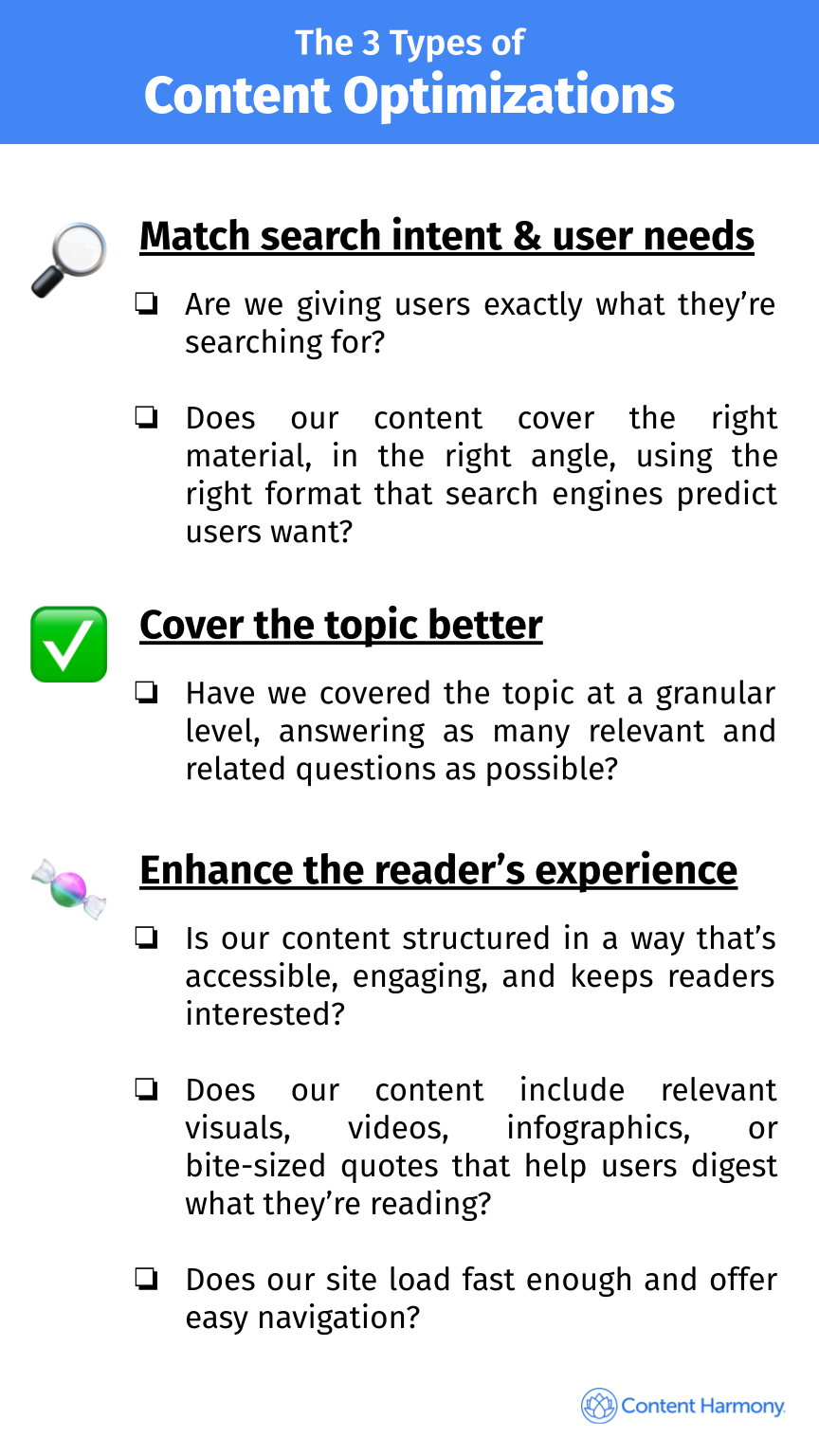
1 - Optimize for search intent & user expectations
- Are we giving users exactly what they’re searching for?
- Does our content cover the right material, in the right angle, using the right format that search engines predict users want?
2 - Optimize for topic coverage
- Have we covered the topic at a granular level, answering as many relevant and related questions as possible?
3 - Optimize for enhanced user experience
- Is our content structured in a way that’s accessible, engaging, and keeps readers interested?
- Does our content include relevant visuals, videos, infographics, or bite-sized quotes that help users digest what they’re reading?
- Does our site load fast enough and offer easy navigation?
Why is content optimization important?
Content optimization is important because without it, all the time and resources you’ve spent creating the content can go to waste. When you optimize content, you’re giving yourself the best possible chance for search engines to index and rank your content, and for users to engage with it, share it, link to it, convert to a paying customer, and more.
This opens up a whole new avenue where people can find your content organically, allowing you to get the full value from your content investment. Optimizing content for SEO in particular is an incredibly powerful growth lever for your business.
How to optimize content for SEO (and readers)
The following checklist covers the most critical search engine optimization steps. If you follow all of these consistently, you’ll see much better results from your content marketing efforts.
For this guide, we’re going to assume you already know the core keyword/topic you want to rank for.
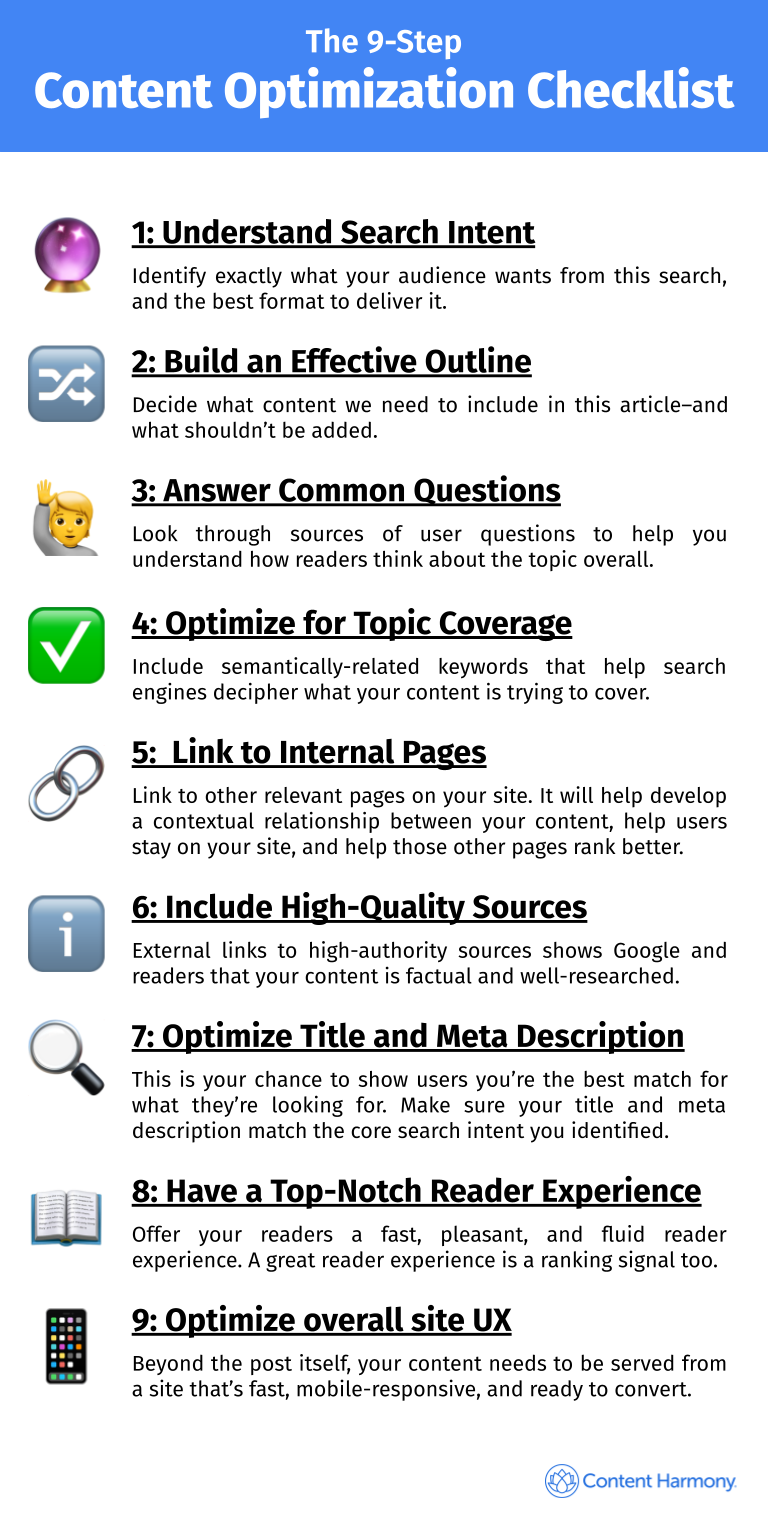
Let’s dive in:
1. Understand the search intent that you need to match
Correctly identifying and addressing search intent can make or break your content program. If you can’t identify exactly what your audience wants from this search, you risk spending your time building content that simply won’t get the search results you want.
What that means is if you’re trying to cater to a high-purchase intent search (eg “wicker patio sets under $500”) with mostly informational content (eg “how to pick a wicker patio set”, then the chances of you ranking well in the SERPs has just been greatly reduced, at least for that high-purchase intent query.
Google makes it pretty clear how important search intent is when it comes to ranking. In its search quality evaluator guidelines, there’s an entire section dedicated to understanding what users want from their search queries, and providing general guidelines for quality control.

If you nail search intent right at the beginning of the research process, the rest of your content optimization strategy will flow smoothly.
For years, SEOs have classified search intent into 3 broad categories:
- Navigational ⇒ Users want to find a specific page or site, such as googling ‘Twitter’ instead of typing twitter.com in their browser.
- Informational ⇒ Searchers need answers to their queries and will include modifiers like “how to”, “what is”, why does” inside their search terms.
- Transactional ⇒ Users want to complete an action of some sort. This could either be a purchase, represented by a search such as “hiking boots under $150”, or a query that leads to a conversion, such as “salesforce demo signup”.
Honestly, this is just a broken system overall, for the reasons that Kane lays out in our post, There’s A Better Way to Classify Search Intent. In short, marketers need to understand intent beyond a simplistic 3-part system, and our software has helped automate the process when you’re doing keyword research or building a content brief.

In some cases, we find there’s split search intent, where Google assumes that the search term can be addressed with multiple methods. A great example is “fish oil”, which includes results for eCommerce category/product pages, informational articles, nutritional facts, and Google News results.
Clearly, Google understands that you might want a variety of different options with such a broad query.
On the other hand, let’s say you’re trying to rank for the term “fish oil benefits”. From the outset, it seems more clear that the user wants to understand the benefits of incorporating fish oil into their daily diet, and the possible downsides or risks this might have in the long term.
Content Harmony correctly classifies this search as Research Intent, but also helps you spot that there are strong signals that users are looking for video content, too.

Clicking on the SERPs confirms the video intent signals. Google serves up video content about halfway through the first page, indicating that it believes many users want to stream videos for this search query, too.
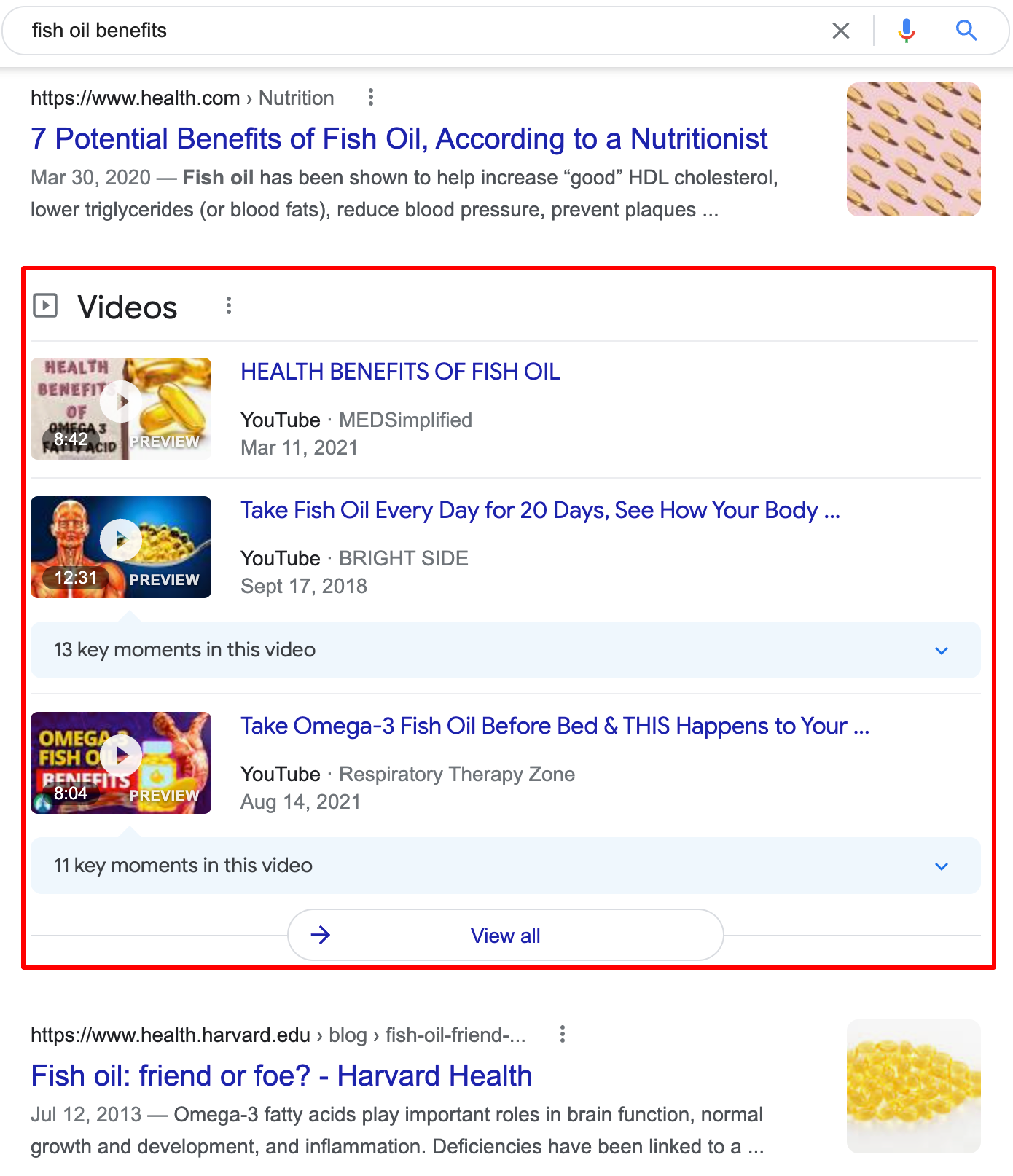
Without proper research, you might have written a long-form blog post about the topic and called it a day.
While that approach is the right place to start, it’s clear that including video content for this term will give you the best possible chance at ranking well. A fully optimized content asset will serve both of these intent types.
We can’t overstate the importance of correctly identifying and catering to search intent — it should be the first step in your content optimization checklist.
2. Build an effective content outline
Once we understand search intent the next step is to build out our initial outline and decide what content we need to include in this article–and what topics we shouldn’t include in this particular outline.
We usually approach this in two ways - first understanding core sub-topics, and second, reviewing competitor outlines to make sure ours is better.
Make sure our outline covers the most critical sub-topics
One of the things that our keyword report for “fish oil benefits” inside of Content Harmony shows us is Related Keywords data:

These are literally the same related keywords that Google shows us on almost every SERP:
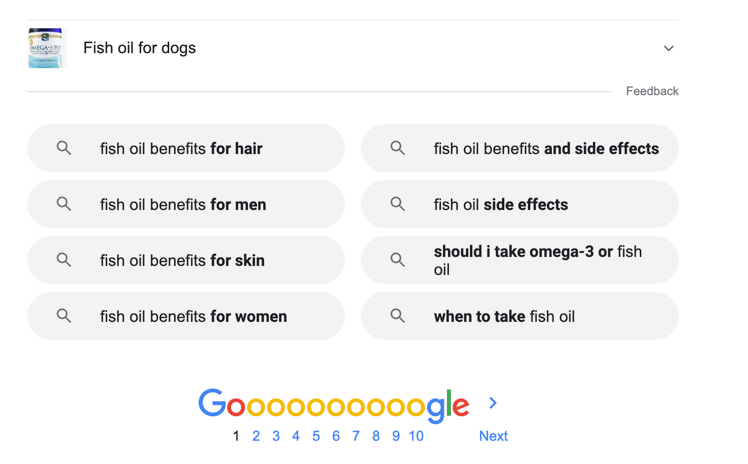
From looking at this, it’s clear that an effective article about “fish oil benefits” should go into essential sub-topics like
- Benefits for sub-groups like men and women
- Benefits to different body parts like skin, hair, etc
- Side effects or risks of fish oil
- When to take fish oil (dosage? Time of day?)
- Whether it’s right for the reader (“should I take?”)
Including these sections in your content is a cheat code for better search rankings. When producing content, you want your content to be viewed as the most authoritative source for that query — related searches are a strong signal from Google that users want the answers to these sub-queries.
Review the best highlights from competitor outlines
While we don’t encourage copying the same approach that your competitors have taken, studying their structure and heading strategy is one of the fastest ways to understand how to better organize your own outline.
You should be looking for ways to structure your content more clearly, as well as looking for content gaps you can use to differentiate your content and cover the topic more comprehensively overall.

3. Answer common reader questions
Accurately and clearly answering related questions and search terms is our next important step in making sure our outline is complete. Keyword research at the search intent stage helps you fully understand what users want from their query - but looking through other sources of user questions will help you answer more specific variations and understand how readers think about the topic overall.
The Question Analysis section in Content Harmony scrapes related questions from Google PAAs (People Also Ask), Reddit, Quora, and Stack Exchange. Answering these questions, particularly those that appear in Google PAAs, increases the chances that you will show up in that section.
More importantly, it helps you understand the voice of the customer and how readers in your market actually talk about this topic.
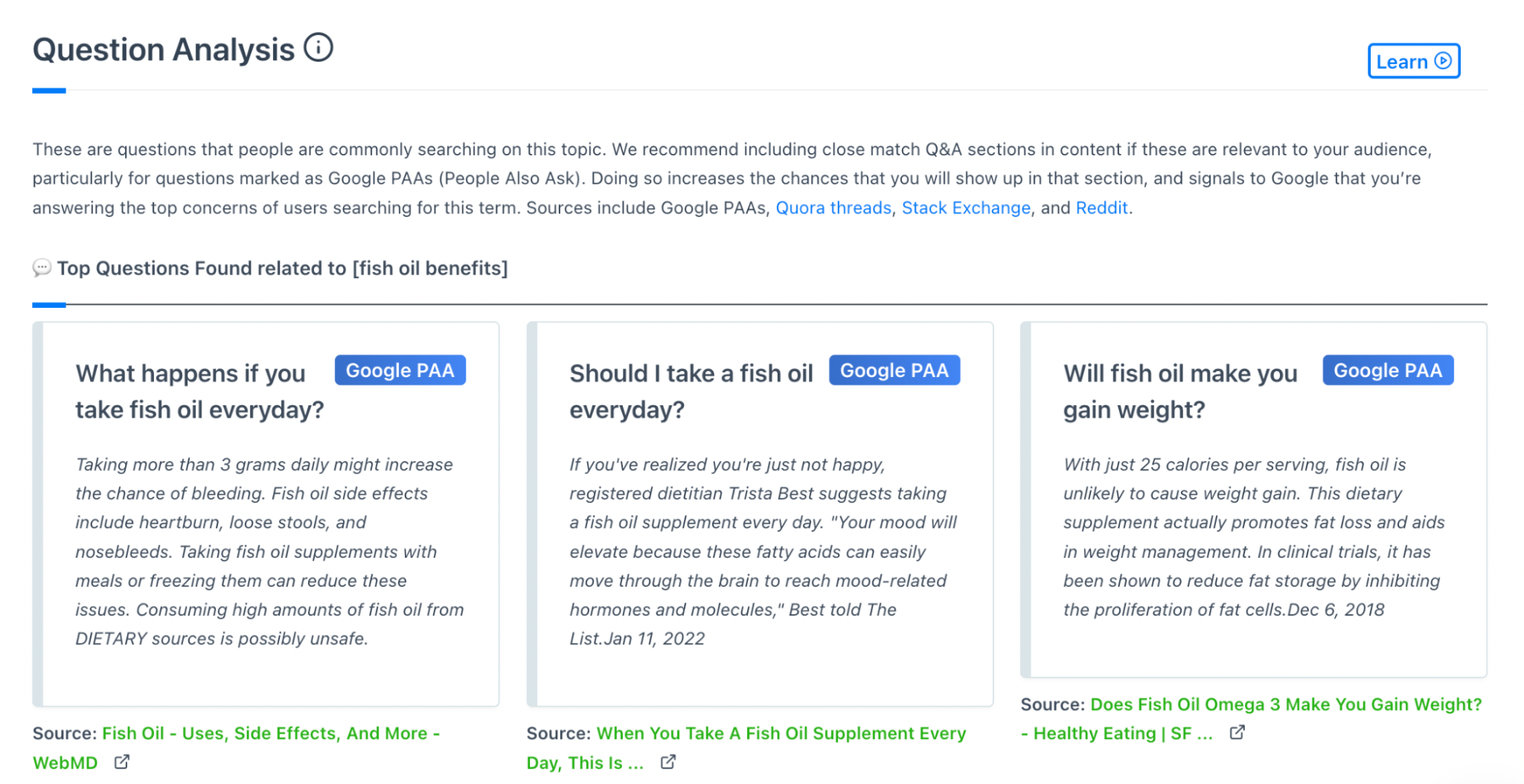
Once you identify good questions, here are the three most common ways to incorporate them into your outline:
- Include an FAQ section towards the end of the post, where you answer the questions directly
- Sprinkle the questions as H2s/H3s throughout your content
- Answer the questions implicitly in your post (meaning the reader will know the answer by the time they’re done reading)
If those variations don’t fit in your current article, use them to fill out new content ideas in your editorial calendar.
4. Optimize for topic coverage & comprehensiveness
We’ve now built out an effective content outline that addresses user search intent — at this point, we probably have what we need to start writing a draft.
If you’re building content as a team, this might be where you keep doing additional research to put into a content brief and send it to your writer.
But if you’re writing the article yourself and you’ve properly addressed search intent and built a solid outline, at this stage you should be looking for more nuanced sub-topics that you may not have covered already in your outline or draft.
The best way to do this is with an automated content grader that takes a topic model and checks with sub-topics you haven’t covered yet.
A topic model is a set of keywords, topics, and phrases that are relevant to your core topic. It will usually include phrases that are very specifically related (eg “omega-3s” in our “fish oil benefits” article), as well as more broadly relevant phrases that you’ll likely cover (such as “nutrition”, “hair”, or “cardiovascular health”).
Learn more about Content Harmony's Topic Model.
There are a few ways to build topic models but the most common and most effective approach for SEO and content teams is to rely on a topic model generated from the content that is currently ranking for your target query.
Navigating back into the Topic Analysis section, Content Harmony suggests multiple semantically-related keywords that are used by the top-ranking competitors for our target query.
We specifically prioritize our topic model based upon which phrases are most commonly used, helping you focus on the most relevant phrases that should appear in your content.
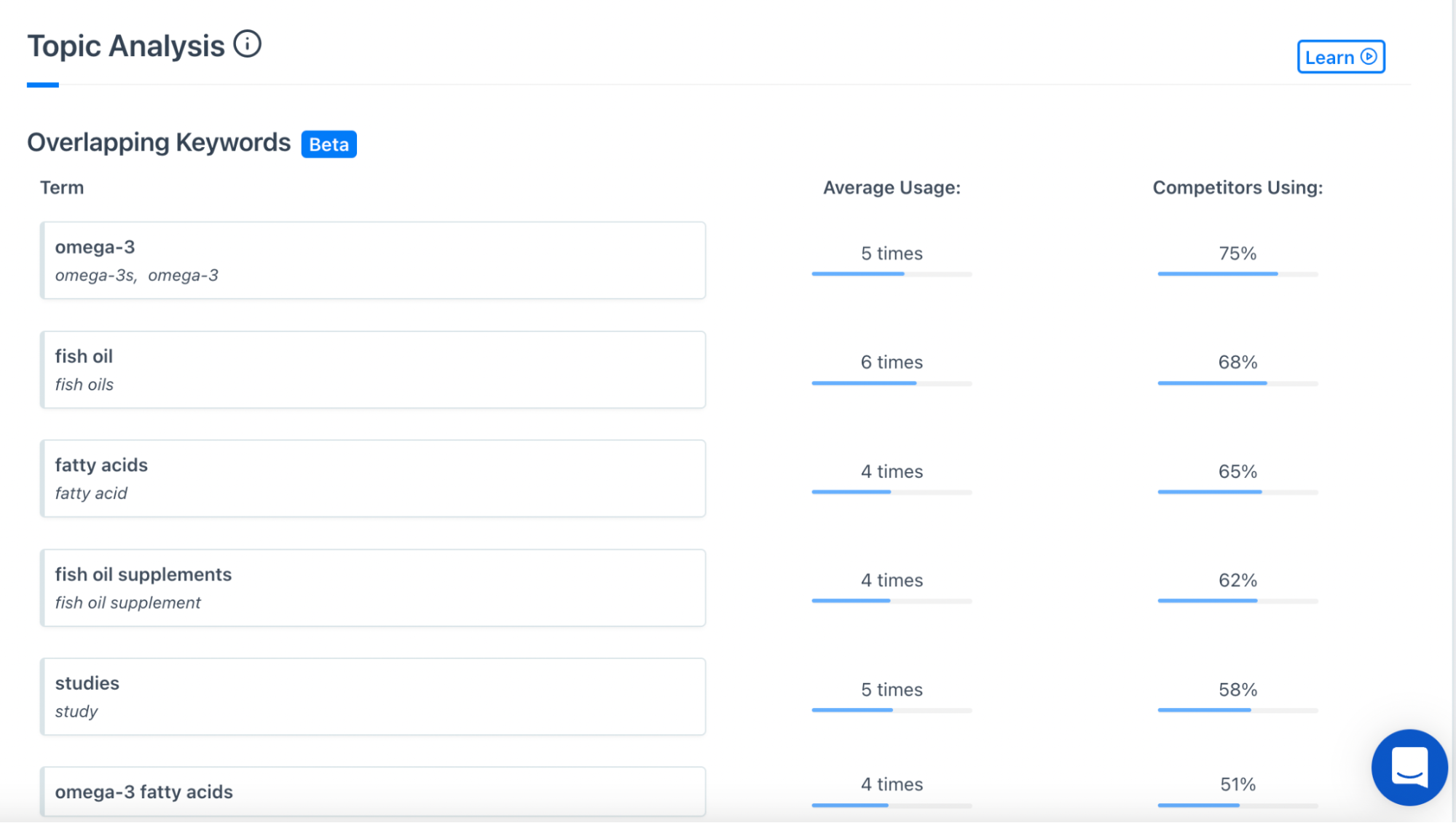
In the olden days of SEO, you would literally have to check for all of these phrases in your content manually to compare your draft against the content that was ranking well.
Nowadays, it’s much faster and more reliable to use a content grader to check for these phrases automatically.
Here’s what Content Harmony’s Content Grader looks like in action:
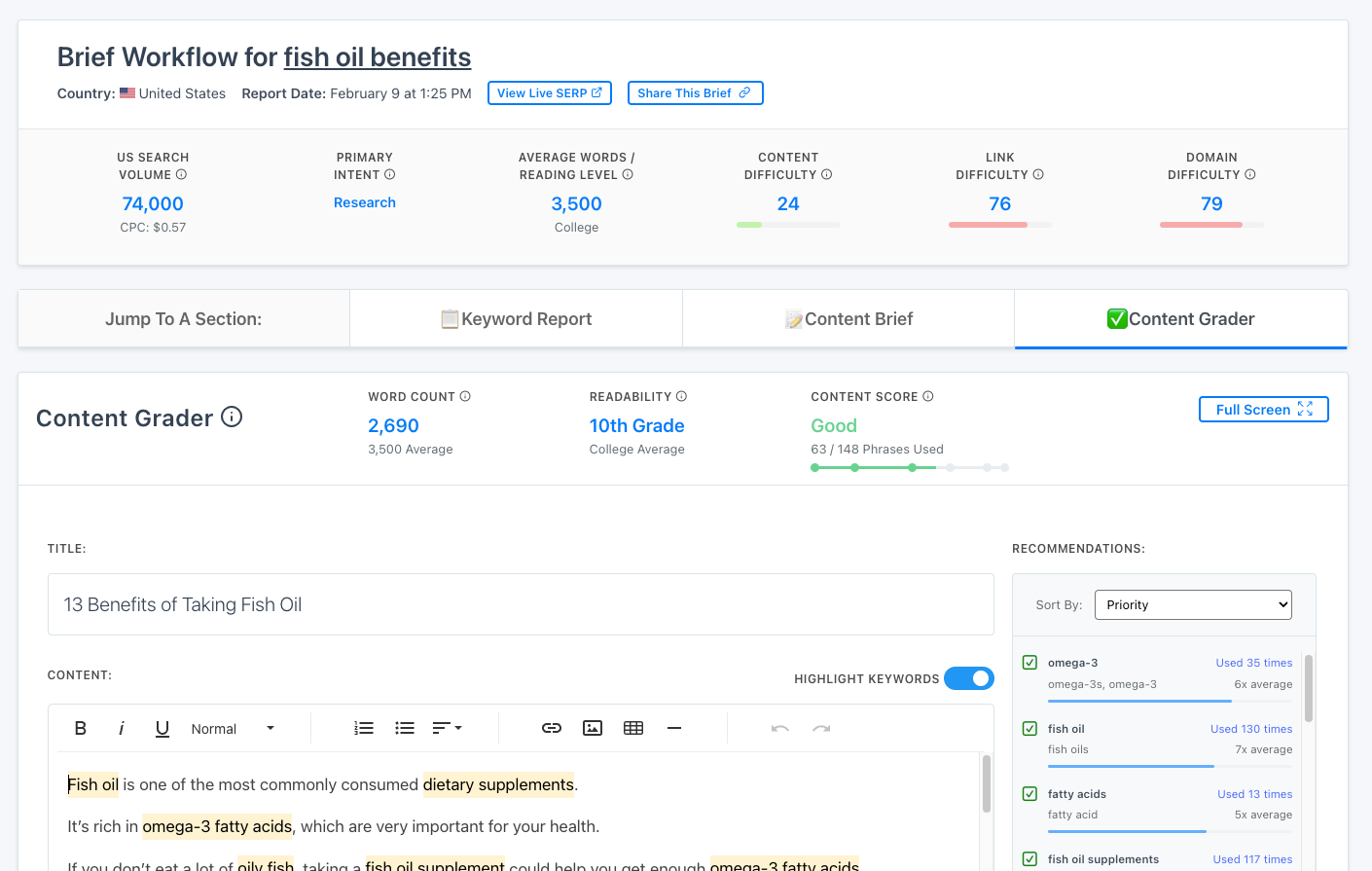
A content grader isn’t a holy grail that tells you exactly what you need to write.
Nonetheless, it’s the best way to spot common phrases and sub-topics that you haven’t included in your content yet.
It also serves as a fast final check that you’ve covered the topic comprehensively, without having to check for every keyword manually on your own.
5. Link to relevant pages on your site
Internal links develop a contextual relationship between your content and are a signal to search engines about the topical authority of your website. For example, if you’ve written about a topic that’s mentioned in another blog or web page, simply link back to it.
Not only is that best practice, but it’s also useful for readers who would like to learn more too.
The more content you create about a certain topic, the higher the interlinking opportunities. For a large site like NutritionFacts.org writing about ‘fish oil benefits’, we see a bunch of great internal link opportunities, such as:
- “benefits of eating fish”
- “is fish oil just snake oil”
- “the risks of fish oil supplements”
- the topic page itself for “fish oil”
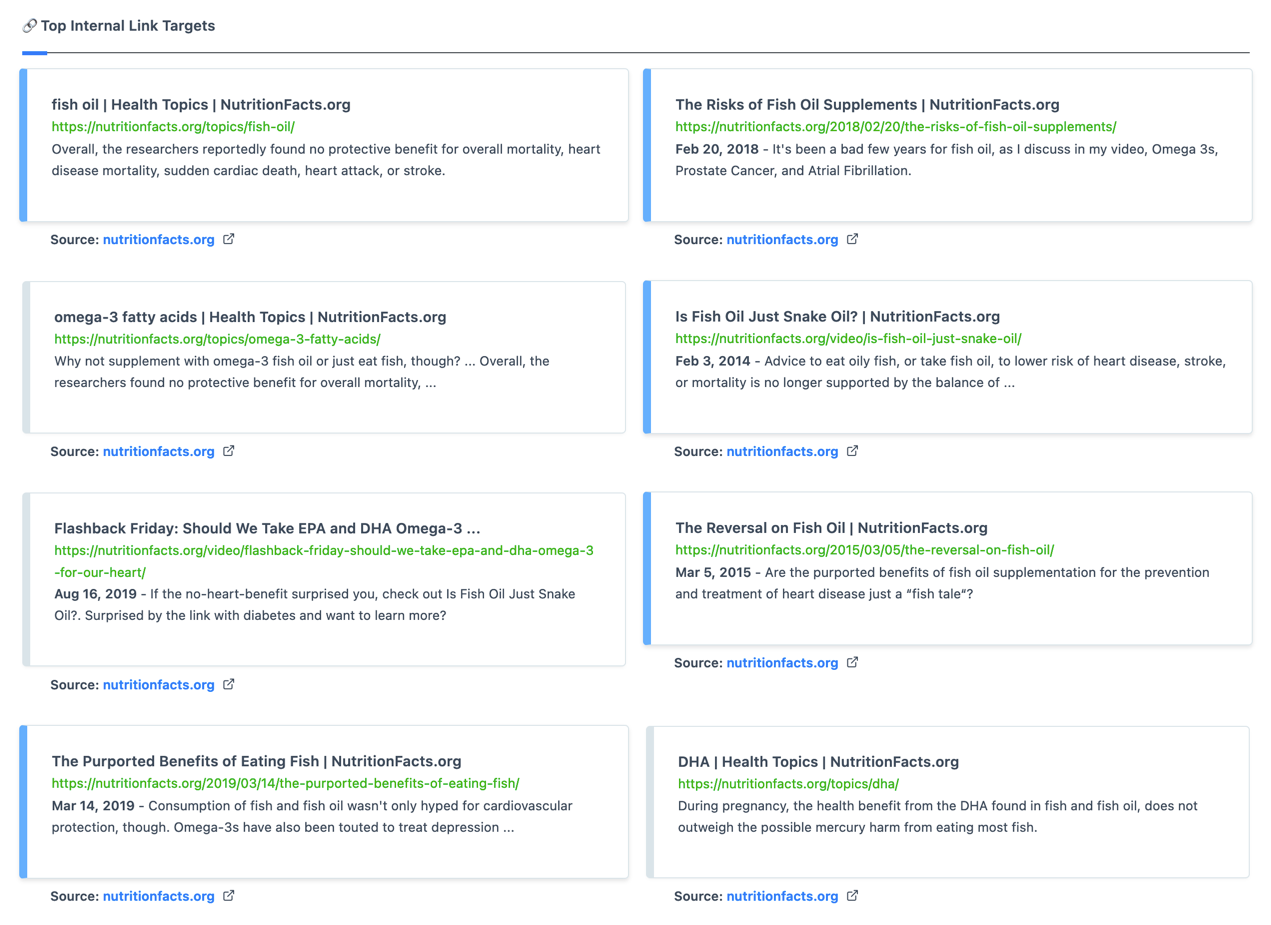
The more content we create, and the more we link to each other, the higher the chances of ranking well in the SERPs. That’s because it’s a signal to search engines that we have plenty of content in the content marketing niche, and that we should be considered a topical authority on the subject.
When you build a brief in Content Harmony, our workflow will automatically identify the most relevant internal pages for that search query, saving you time and simplifying your workflow.
6. Cite credible, high-authority external sources
An additional method you can use to display authority to search engines is by including credible external links in your content. Navigating over to Content Harmony’s ‘Sources’ tab gives you a plethora of high-authority sources for your search query.
In the case of ‘fish oil benefits,’ we’re able to see overlapping links (these are external links being cited by multiple competitors), trustworthy sources from government and educational websites, and top news results.
The folks at Reboot Online ran an interesting experiment that demonstrates the effectiveness of using high-authority educational sources.
They created 10 brand new websites, each trying to rank for the same keyword. The sites that included external links to educational websites ranked higher than those that didn’t:

So, back to our Keyword Report–there are a few notable .GOV and .EDU resources showing up that we might want to reference:
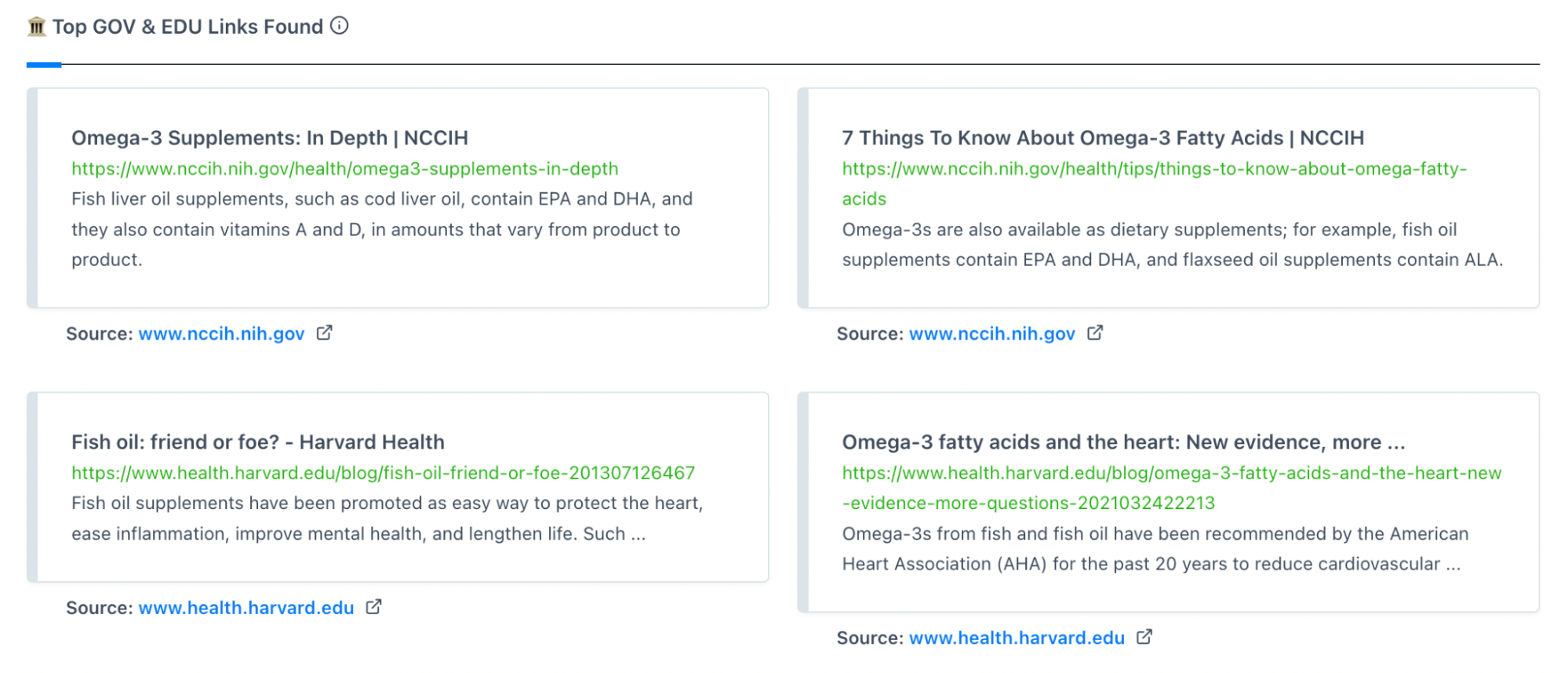
Of course, you will come across other sites too during the process of your research. If you’re struggling to determine whether it’s an authoritative source or not, consider the following:
- Does the site include other content relevant to the niche you’re talking about?
- Is it a primary source?
- Is the site credible and has a good reputation?
- How old is the page?
- Are the statistics recent?
- Does the author have a history of writing about similar topics?
7. Optimize title tag and meta description
Your blog’s title tag is the first step for search engines to determine the relevance of your content for specific keywords. The meta description helps draw in readers by showing them that you’re covering the core related sub-topics they want to learn about.
In both cases, this is your chance to show the user how well you understand the intent behind their search.
For example, the title tags for the top 3 results in “fish oil benefits” are highlighted below.
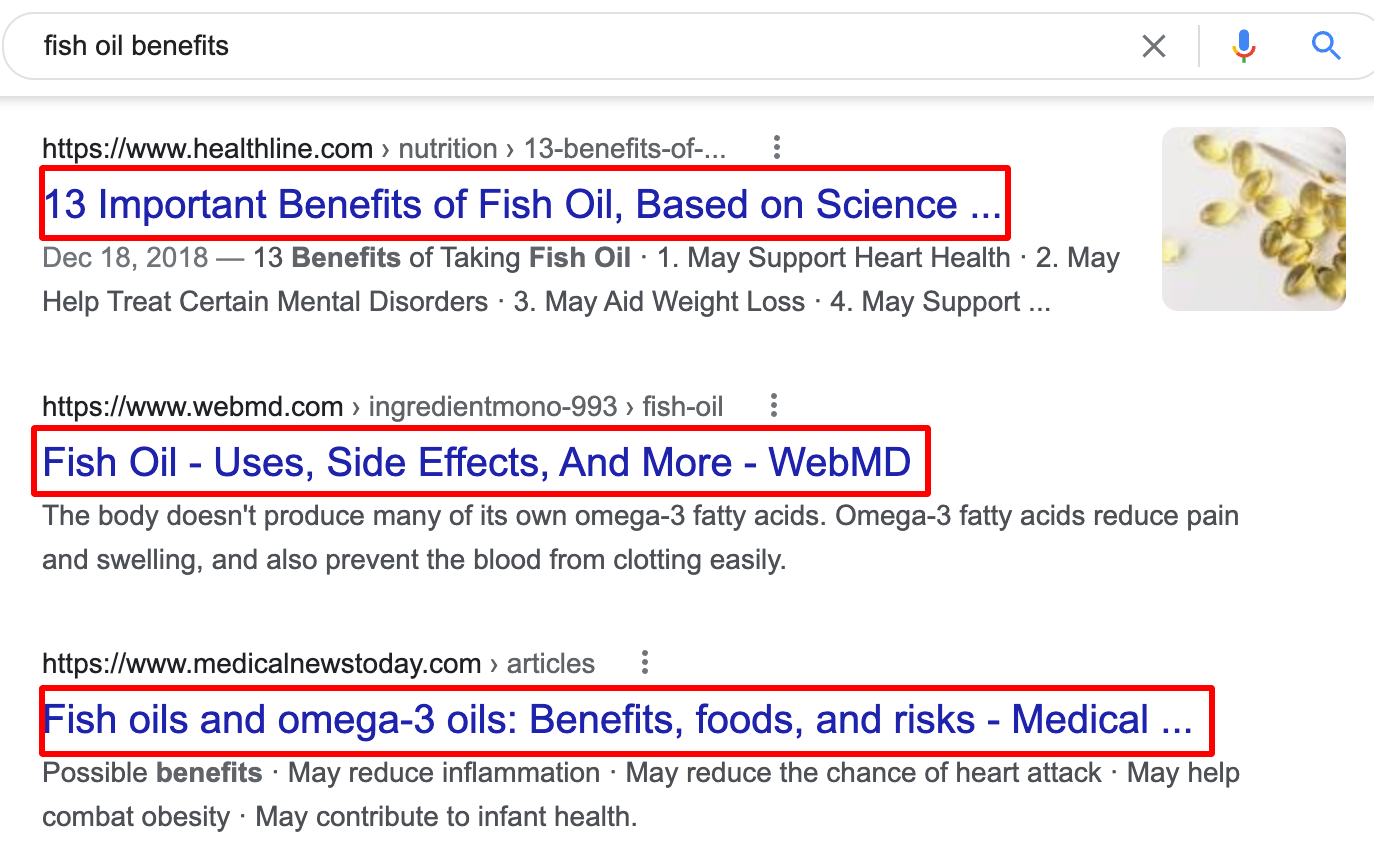
Including a keyword in your title tag is vital, ideally within the first 60 characters. Title tags longer than that are cut off by the SERPs (the third example shows that clearly).
If you can’t include all the information you’d like in your title tag, don’t worry. The meta description is another opportunity for you to give both search engines and readers information about your content.
The maximum recommended length for meta descriptions is about 300 characters, so there’s an opportunity here to go into a bit of detail. There is a slight chance that Google might not pull the same title tag and meta description that you specify in your CMS, but we recommend that you continue to optimize both for best results.
8. Have a top-notch reader experience
Google loves indexing and ranking URLs that offer a fast, fluid, and pleasant user experience. Here are some tips you can use to ensure that readers have a great experience on your site:
Go easy on the pop-ups:
Google considers popups to be intrusive, spammy, and doesn’t like them much. If you must include popups, do so at exit intent. Tempting as it might be to offer discount codes or ask for email addresses as soon as users land on your page, it’s definitely going to hurt your SEO.
I'll never understand why people trigger popups for the second someone lands on their site.
— Alex Garcia 🔍 (@alexgarcia_atx) February 10, 2022
Format your content well:
Giant walls of text are boring and tedious to read. It doesn’t matter how well-written your content is, your readers aren’t going to scroll through to the end of the page if all they see is black and white font.
Using headers, bulleted lists, and appropriate white space around the text adds clarity to your writing and makes it look easier on the eyes.
Add visuals & screenshots:
Placing relevant screenshots, infographics, videos, even GIFs gives you an opportunity to stand out. It’s not just a better user experience, it helps you explain a complex subject you might be trying to address with your content or showcase some related statistics to drive home the message.
It’s also commonly accepted that the time people spend on your page is a blog SEO ranking factor. Visuals keep people hooked and engaged with your content, and the more time they spend reading your article, the better it is to boost rankings.
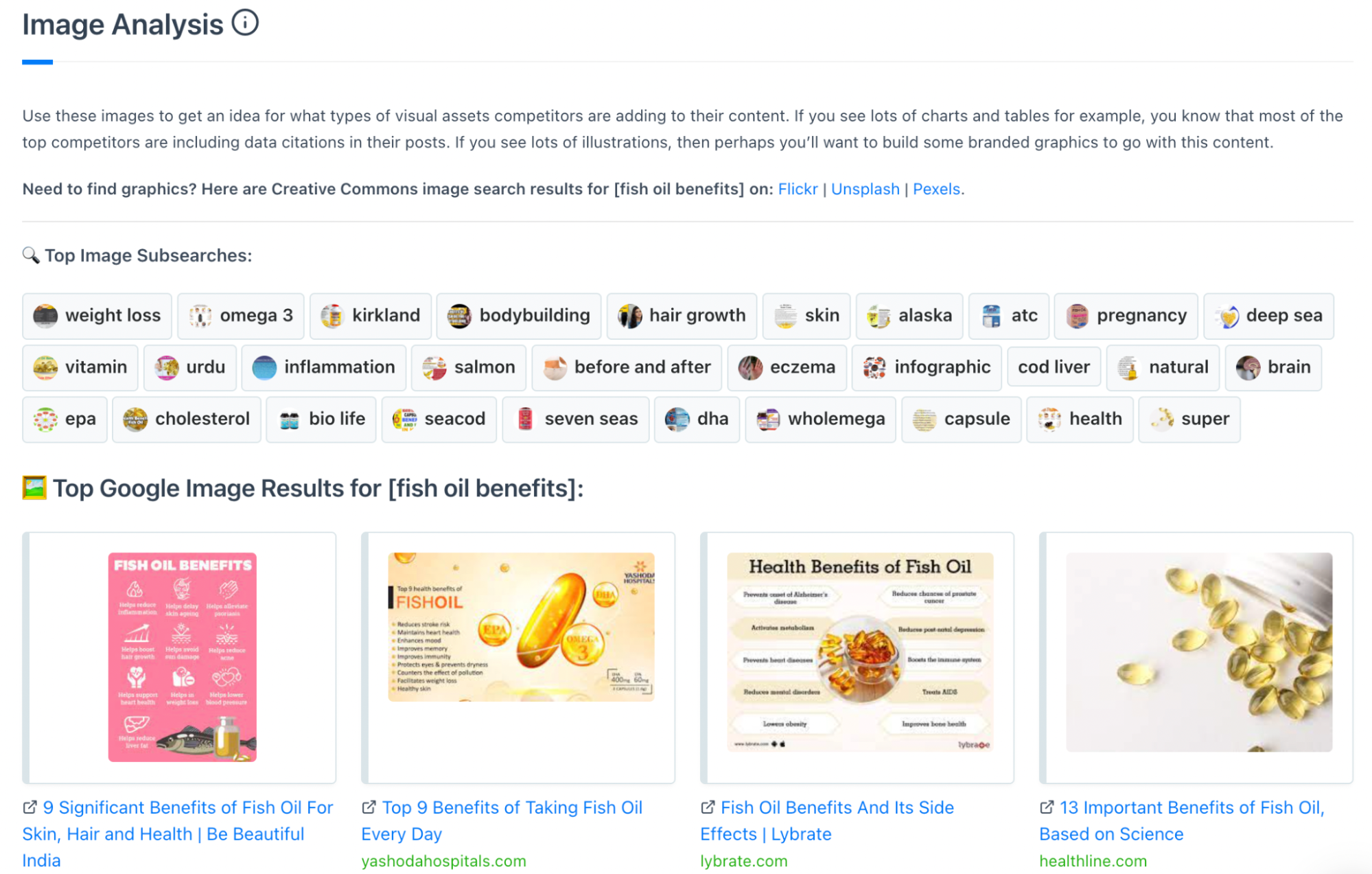
Make your content easier to read:
The average American reads at a grade eight level, so if your writing is hard to understand and full of jargon, don’t expect great engagement with your posts.
But that said, sometimes people are searching for complex topics and want more advanced content. So it’s OK to publish content with college-level readability if that is what your users expect.
Nevertheless, you should still try to explain the concepts succinctly and clearly for the user.

The editor, style checker, and de-jargonizer tools in our best content writing tools post should help remove some of the fluff from your content. Additionally, we recommend that you use short, punchy sentences and paragraphs that don’t exceed four to five lines.
All Keyword Reports created in Content Harmony use Flesch-Kincaid scores to analyze the top-ranking pages for that keyword, and show you an average “readability score”. The content grader will do the same for your content, helping you adjust as needed.
Include image alt text:
Google image search is an underrated aspect of content optimization with many publishers overlooking the importance of alt text.
Alt text, an attribute that can be added to an image tag in HTML, tells search engines what the image is about. While humans may be able to look at an image and make their own conclusions, search algorithms don’t function in the same manner. Alt text helps guide them tells them what the image represents and is definitely a ranking factor.
When writing alt text, describe the image as if you were trying to explain it to someone who has their eyes shut. Be specific, try to keep it under 125 characters, and don’t include the text “this is an image of”. Add a keyword if you like.
9. Optimize the rest of your site UX beyond the content itself
Beyond the post itself, your content needs to be served from a site that’s ready to convert readers and give them a good experience. Most of that boils down to two focus areas:
Improve page speed:
If your site doesn’t load in three seconds or less, expect most visitors to close the tab altogether. Hence, it doesn’t matter how good your content is, the slow site speed will dissuade most from exploring further.
What’s more, site speed has been a ranking factor for Google since 2010 so if you’re not optimizing for fast load times, you run the risk of sluggish SEO results.
As a first step, navigate over to the Page Speed Insights tool. It’ll tell you how fast your site is and suggest areas of improvement. You can also use the HTML-cleaner tool, which shows you unnecessary code and how to remove it.
Optimize your mobile experience:
Google moved to mobile-first indexing in 2019, which means it primarily uses the mobile site version for indexing and ranking. Hence if your site isn’t set up to be responsive and easy to read on mobile devices, expect your rankings on the SERPs to be affected, too.
To see how well your site performs on mobile, check out the Page Speed Insights tool again. It gives you a detailed overview of how Google analyzes your performance, both on the desktop and mobile versions. Those optimization suggestions are a good place to start improving your mobile experience.
In most industries a mobile device is the most common way for readers to experience your content, so make sure it’s easy to read on mobile devices. Most of the time this means building a responsive website and using large enough fonts.
Going beyond on-page content optimization
Other than on-page edits and site optimization, there are a couple of additional steps you can take to help your content reach more readers.
Consistently promote your content
No matter how optimized it is for search, publishing content is never the final step of the content lifecycle. You want more people to read it, right? Well, instead of relying on them to stumble across it organically through search engines, there are a number of things you can do to promote it.
A content distribution strategy is often as important as a regular publishing cadence.
Broadly speaking, distribution can be bucketed into three main channels:
- Owned channels: Examples of owned channels include your email list, social media accounts, website popups, and other digital properties that you control. Promoting your content on these channels should be the first step of your distribution strategy since it will reach people already interested in your product or service.
- Earned channels: Ever get the feeling of excitement when a stranger shares your content? That’s an example of an earned channel. Said channels include guest articles, social shares, journalists and bloggers, and product review sites.
- Paid channels: Sponsored content, paid social ads, and PPC campaigns are effective when you’re in the early stages of building your audience and would like to get the message across quicker.
Update and refresh old content periodically
A content refresh can breathe new life into existing content — posts that used to get a lot of traffic but perhaps don’t rank for as many keywords anymore.
Updating your posts with new data helps optimize content and prove to search engines that it’s still an authoritative source for the search query.
Our recent post on how to refresh content gives you a two-step framework to help you understand which content deserves to be updated, and best practices on how to go about doing it.
Want to see how Content Harmony helps you build content that outranks the competition?
The blog post you just read scores Good in our Content Grader for the topic "how to optimize content for SEO".
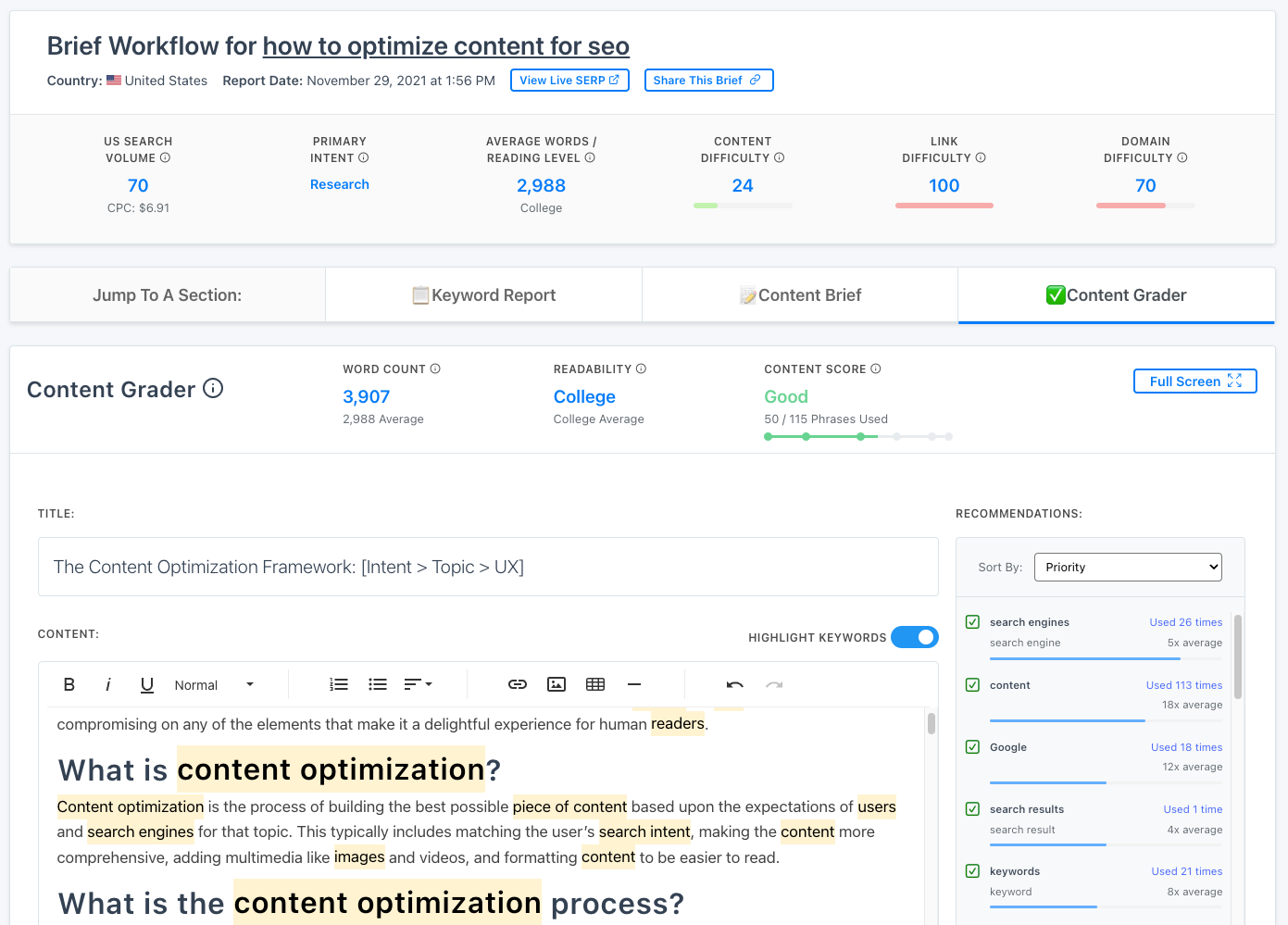
Grade your content against an AI-driven topic model using Content Harmony - get your first 10 credits for free when you schedule a demo, or sign up here to take it for a spin on your own.
👉 Get Your First 10 Briefs For $10
✉️ Get an email when we publish new content:
Don't worry, we won't bug you with junk. Just great content marketing resources.
Ready To Try
Content Harmony?
Get your first 10 briefs for just $10
No trial limits or auto renewals. Just upgrade when you're ready.

You Might Also Like:
- The Wile E. Coyote Approach To Content Guidelines
- Content Brief Templates: 20 Free Downloads & Examples
- The Keyword Difficulty Myth
- How To Find Bottom of Funnel (BoFU) Keywords That Convert
- Bottom of Funnel Content: What Is BOFU Content & 10 Great Examples
- 20 Content Refresh Case Studies & Examples: How Updating Content Can Lead to a Tidal Wave of Traffic 🌊
- How to Create Editorial Guidelines [With 9+ Examples]
- Content Marketing Roles
- How To Write SEO-Focused Content Briefs
- How To Update & Refresh Old Website Content (And Why)
- 12 Content Marketing KPIs Worth Tracking (And 3 That Aren't)
- 16 Best Content Writing Tools in 2024 (Free & Paid)
- How to Create a Content Marketing Strategy [+ Free Template]
- How To Create Content Marketing Proposals That Land The Best Clients
- What Is A Content Brief (And Why Is It Important)?
- How To Create A Dynamite Editorial Calendar [+ Free Spreadsheet Template]
- How to Use Content Marketing to Improve Customer Retention
- Types of Content Hubs: 5 Approaches & 30+ Examples
- How To Do A Content Marketing Quick Wins Analysis
- There's A Better Way To Measure Keyword Difficulty

